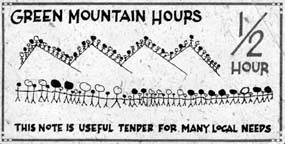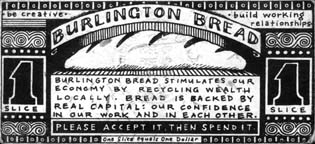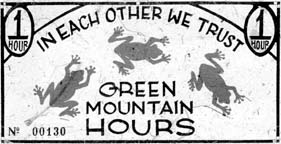Think Globally, Spend Locally
By Joe Mueller
Let’s look at the Seattle demonstrations against the World
Trade Organization. What are the protesters actually protesting about?
For one thing, they are angered about the removal of funds from local
economies to some multi-national company. The money is earned for the
company in a relatively small community and then, as if driven away
in armored cars, taken out of that community to the vaults of the parent
company located far from the working area. The local area suffers from
the removal of funds from its economy while the parent company gets
richer. Granted, this description is a bit simple, and at the same
time, hyperbolic—my understanding of the greater workings of economics
is unnaturally low.
What I do know is that local people
around Vermont and the United States have been working with local currency
plans in an attempt to revitalize small local economies and build a
sense of community amongst people who utilize these systems. What,
you may ask, is local currency? Is it legal? After all, printing up
counterfeit money brings the full wrath of the FBI down upon the counterfeiter,
or those who pass counterfeit bills, and everyone knows that passing
bad checks is, well, bad.
The U.S. government states that local
currencies (rural or urban) are perfectly legitimate as long as the
monetary units can be distinguished from federal dollars. The IRS considers
exchanges made with these currencies to be subject to taxation at their
 fair market value. What, however, backs these currencies? Gold? Silver?
Promises? Local money is backed by the skills and resources—the
people—of the community. Paul Glover, the founder of Ithaca Hours,
the resoundingly successful local currency program in Ithaca, NY, regards
local currency as “...real money, backed by real people, real
time, real skills and tools.” Glover points out that US dollars
are no longer backed by anything solid, neither gold nor silver, but
really, less than nothing— $4.3 trillion of national debt.
fair market value. What, however, backs these currencies? Gold? Silver?
Promises? Local money is backed by the skills and resources—the
people—of the community. Paul Glover, the founder of Ithaca Hours,
the resoundingly successful local currency program in Ithaca, NY, regards
local currency as “...real money, backed by real people, real
time, real skills and tools.” Glover points out that US dollars
are no longer backed by anything solid, neither gold nor silver, but
really, less than nothing— $4.3 trillion of national debt.
How does local currency work? Well, the same as US dollars with one
Caveat: the currency cannot leave the local area. You can only exchange
local currency for goods and services in your community. Vermont has
three active local currency programs: Burlington Bread in Burlington,
Green Mountain Hours out of Montpelier and Buffalo Mountain Hours based
 in Hardwick. Each of these currency programs prints bills of different
denominations, publishes a directory of individuals, merchants and
retailers who use the local currency, and disburses the currency to
those who join the program. Some participants in the programs (retailers,
etc.) will accept 100% of the local currency for every transaction.
Other participants might only accept a smaller percentage of the purchase
paid in local currency, the remainder paid in federal dollars.
in Hardwick. Each of these currency programs prints bills of different
denominations, publishes a directory of individuals, merchants and
retailers who use the local currency, and disburses the currency to
those who join the program. Some participants in the programs (retailers,
etc.) will accept 100% of the local currency for every transaction.
Other participants might only accept a smaller percentage of the purchase
paid in local currency, the remainder paid in federal dollars.
I traveled to Burlington and Montpelier to see how the local currencies,
Burlington Bread and Green Mountain Hours, have been received in those
cities. As I talked to people and researched the topic of local currencies,
my initial focus was on discovering how “successful” they
were in terms of acceptance and numbers of bills in active circulation.
Yet in listening to people talk about the various programs in Vermont,
I realized that while local currencies are an economic system,
a substitution of local for federal currency, they are more than that.
Local currencies are as much about creating a sense of community around
shared values and concerns as they are about economic transactions.
Green Mountain Hours have been printed in four denominations:
one Hour ($10), one-half Hour ($5), one-quarter Hour ($2.50), and one-tenth
Hour ($1). A Service Directory lists the goods and services that people
are willing to provide in exchange for local currency. This Service
Directory includes the phone numbers and business addresses of the
participants. People who want to be listed in the Directory pay a $5
fee, for which they are given four GMH—the equivalent of $40—to
spend and recirculate into the community.
The Green Mountain Hours
Service Directory includes tax accountants, graphic designers, movie
theaters, bookstores, construction companies, restaurants and more,
all willing to accept GMH. There are about 120 participants in Green
Mountain Hours right now; 75% individuals and 25% established retail
businesses.
Steve Gorelick, who is involved with the Montpelier
local currency, says he would like to see more participants, especially
retailers of “hard goods” (food, clothing etc.) get involved.
“One of the problems,” Gorelick says, “is that people
 have the perception that local currencies are only exchangeable for
services like massage. We have to let people know about the wide variety
of exchangeable goods and services available to them with GMH.”
Montpelier restaurants The Wrap and Horn of the Moon Cafe accept Green
Mountain Hours. The Savoy Theater accepts Hours as a percentage payment
for movie admissions. Moon Mountain Clothing Store accepts GMH for
new and used clothing.
have the perception that local currencies are only exchangeable for
services like massage. We have to let people know about the wide variety
of exchangeable goods and services available to them with GMH.”
Montpelier restaurants The Wrap and Horn of the Moon Cafe accept Green
Mountain Hours. The Savoy Theater accepts Hours as a percentage payment
for movie admissions. Moon Mountain Clothing Store accepts GMH for
new and used clothing.
Gorelick says that GMH is trying to fill
in some gaps in their directory. “If we can get more providers
of basic goods, like the Coop, it would be easier for us to attract
a dentist. If we get a dentist, an auto mechanic might participate.”
Green Mountain Hours become more appealing and more useful as more
people with different skills and goods participate. Gorelick says that
there is a definite need for food coops to join in the program. “If
people could buy their basics needs with GMH, we could ensure more
participants, more Hours circulating in the area.”
“There
is an understandable conservatism among small business owners,”
Gorelick says. Small business like local bookstores and restaurants
have to purchase much of their stock and supplies from out of the local
area. “It’s ironic,” says Gorelick, “that the businesses
we are most trying to help (small local shops) are often the most reluctant
to participate. By accepting GMH, the local shops help keep business
in town instead of away at a mall or a Wal-Mart or a McDonalds.”
But some business owners claim they cannot use Green Mountain Hours,
not only because they must purchase their stock with US dollars, but
because they don’t feel that there are items or services listed
in the GMH directory that they can use either for their business or
for themselves. This problem seems to be one of cyclic participation.
The more businesses willing to participate, the wider variety of goods
and services available. More exchangeable goods means more people will
participate, thus, more and different products available.
Fred
Wilber, owner of BuchSpieler Records says, “I support the idea
fully but I do not use Green Mountain Hours. None of my suppliers,
the people I do business with, will accept the Hours as payment. There
just aren’t that many services or things I can use for my personal
use from GMH participants.” This is just one of the impediments
to widespread use of local currency.
Rivendell Books in Montpelier
hit another snag with Green Mountain Hours. Owner Kathi McClure once
accepted 100% GMH for purchases. “But then people would come
in and want to use $100 worth of Green Mountain Hours. At first I was
very happy, it seemed like a big success. But then I started accumulating
way too many Hours. I was paying taxes on the currency but not using
them. I couldn’t use all of my Hours and people didn’t want
them as change. In effect, I was losing money.”
This is one
of the reasons that Hunger Mountain Coop in Montpelier does not accept
GMH, says General Manager, Leslie Nulty. “Already, one of our
vendors who has accepted GMH has told us that he would not accept them
from us because he had too many.” Some merchants do not have this
problem. Susan Lawrence, owner of the jewelry and gift shop Phoenix
Rising in Montpelier uses all of her Green Mountain Hours for food
from the Plainfield Coop, for visits to a homeopath and for movies.
One of the problems I discovered while interviewing people in
Montpelier and Burlington about their local currency programs was that
many people, business owners included, were unaware that their city
even had a local currency. This unawareness seems to stem from a lack
of organization and a lack of budget. Someone has to get the knowledge
out, explain how local currencies benefit the community and make people
aware of what local currencies are, how they work, and the benefits
of getting involved. The problem is that this takes time and energy.
Most of the people on the steering committees for Green Mountain Hours
and Burlington Bread already have full time jobs. Even though there
is community participation, there doesn’t seem to be any real
spearheaded coordination to reach possible participants and educate
the public.
Paul Glover, the founder of the successful Ithaca Hours
program, is hosting Burlington organizers late this August to address
the problems of organization and advertising. Glover says that Ithaca
Hours relies on “...regular publication of a directory, press
releases when there are newsworthy events, milestones and accomplishments,
signs on stores, and media publicity.” Glover himself was, for
many years, a one-man advertisement for Ithaca Hours.
Green Mountain
Hours hosts monthly meetings that are open to the public on the third
Monday each month, at the Horn of the Moon Cafe9 in Montpelier. Burlington
Bread features a potluck dinner/ informational meeting each second
Friday of the month. Sadly, these meetings don’t seem to be enough
to get information out to the general populace.
It is argued that
the “success” of local currency systems is not measured solely
in the number of participants, but in the sense of community created
between their members. As Susan Lawrence in Montpelier stresses, besides
strengthening the local economy, “Green Mountain Hours makes us
work more as a cooperative community. By using this currency, we get
to know our neighbors better. We need more businesses courageous enough
to commit to the community by using local currency.”
In that
sense, local currencies take their place among other micro-communities
that spring up around the exchange of shared ideas, interests and values:
civic clubs, food coops, babysitting coops, service organizations,
swing dance clubs, church groups, soup kitchens and any number of volunteer-based
and community groups. Long before Green Mountain Hours, Buffalo Mountain
Hours, or Burlington Bread, communities helped each other out and bartered
for goods and services. Storekeepers extended credit to customers on
the basis of trust and friendship. Neighbors shared equipment on their
farms, pitching in at haying, harvest time, barn raisings and quilting
bees, followed by potluck suppers and dances. And how many chickens,
eggs or apple pies have served as payment through the years for everything
from doctor’s visits to yard work?
While barn raisings and
quilting bees have gone the way of the one-room school house, local
currencies could be regarded as an ancient yet modern reinterpretation.
They work best when there is little money, lots of elbow grease, and
lots of participants. They do not work in isolation—in fact, they
cannot exist without a community, without reciprocity, without shared
values and commitment to the larger group. They are manifestations
of the need to be part of a caring community. That need will always
find solutions, in one currency or another.
For more information
on these local currency programs, check these websites:
For Burlington
Bread: BurlingtonCurrency.org
For Green Mountain
Hours contact Steve Gorelick at:
isecvt@igc.apc.org
For Ithaca Hours: www.lightlink.com/ithacahours
Joe Mueller is a freelance writer, writing
instructor, bartender and bike jock. His lack of understanding of
economics may be due in part to his lack of money. He would welcome
any opportunity to increase his personal familiarity with U.S. Legal
Tender.
Cover
Other issues
Editorial mission
Information for advertisers
Links
Directory
Calendar
Submission guidelines
Suggestions? Send us email
 fair market value. What, however, backs these currencies? Gold? Silver?
Promises? Local money is backed by the skills and resources—the
people—of the community. Paul Glover, the founder of Ithaca Hours,
the resoundingly successful local currency program in Ithaca, NY, regards
local currency as “...real money, backed by real people, real
time, real skills and tools.” Glover points out that US dollars
are no longer backed by anything solid, neither gold nor silver, but
really, less than nothing— $4.3 trillion of national debt.
fair market value. What, however, backs these currencies? Gold? Silver?
Promises? Local money is backed by the skills and resources—the
people—of the community. Paul Glover, the founder of Ithaca Hours,
the resoundingly successful local currency program in Ithaca, NY, regards
local currency as “...real money, backed by real people, real
time, real skills and tools.” Glover points out that US dollars
are no longer backed by anything solid, neither gold nor silver, but
really, less than nothing— $4.3 trillion of national debt.
 in Hardwick. Each of these currency programs prints bills of different
denominations, publishes a directory of individuals, merchants and
retailers who use the local currency, and disburses the currency to
those who join the program. Some participants in the programs (retailers,
etc.) will accept 100% of the local currency for every transaction.
Other participants might only accept a smaller percentage of the purchase
paid in local currency, the remainder paid in federal dollars.
in Hardwick. Each of these currency programs prints bills of different
denominations, publishes a directory of individuals, merchants and
retailers who use the local currency, and disburses the currency to
those who join the program. Some participants in the programs (retailers,
etc.) will accept 100% of the local currency for every transaction.
Other participants might only accept a smaller percentage of the purchase
paid in local currency, the remainder paid in federal dollars.
 have the perception that local currencies are only exchangeable for
services like massage. We have to let people know about the wide variety
of exchangeable goods and services available to them with GMH.”
Montpelier restaurants The Wrap and Horn of the Moon Cafe accept Green
Mountain Hours. The Savoy Theater accepts Hours as a percentage payment
for movie admissions. Moon Mountain Clothing Store accepts GMH for
new and used clothing.
have the perception that local currencies are only exchangeable for
services like massage. We have to let people know about the wide variety
of exchangeable goods and services available to them with GMH.”
Montpelier restaurants The Wrap and Horn of the Moon Cafe accept Green
Mountain Hours. The Savoy Theater accepts Hours as a percentage payment
for movie admissions. Moon Mountain Clothing Store accepts GMH for
new and used clothing.